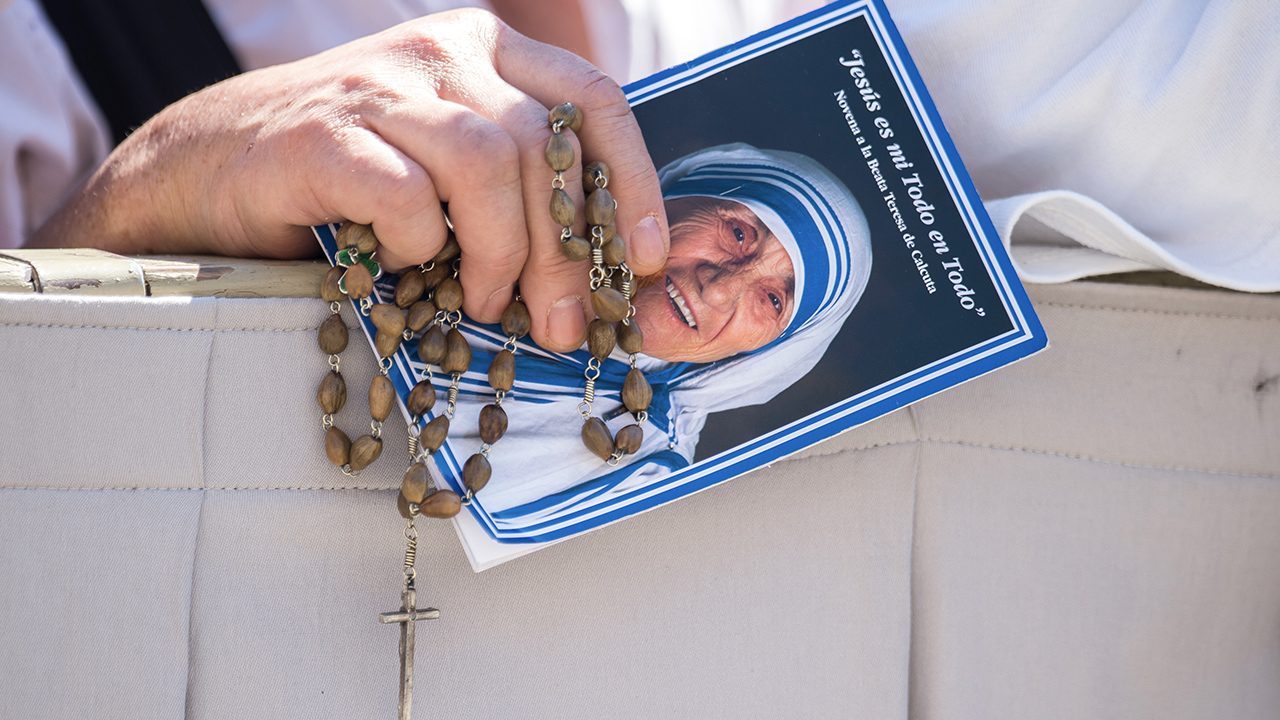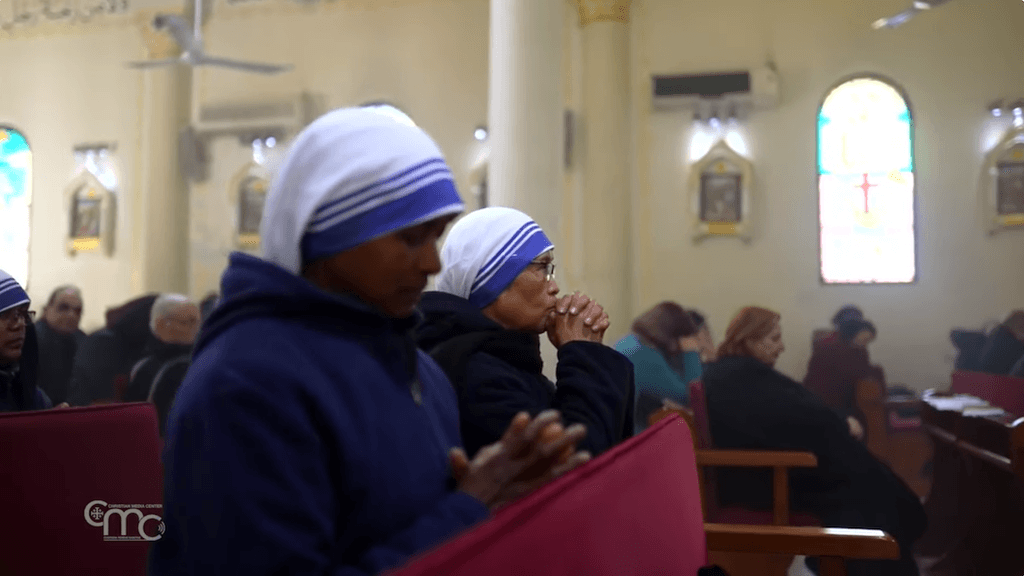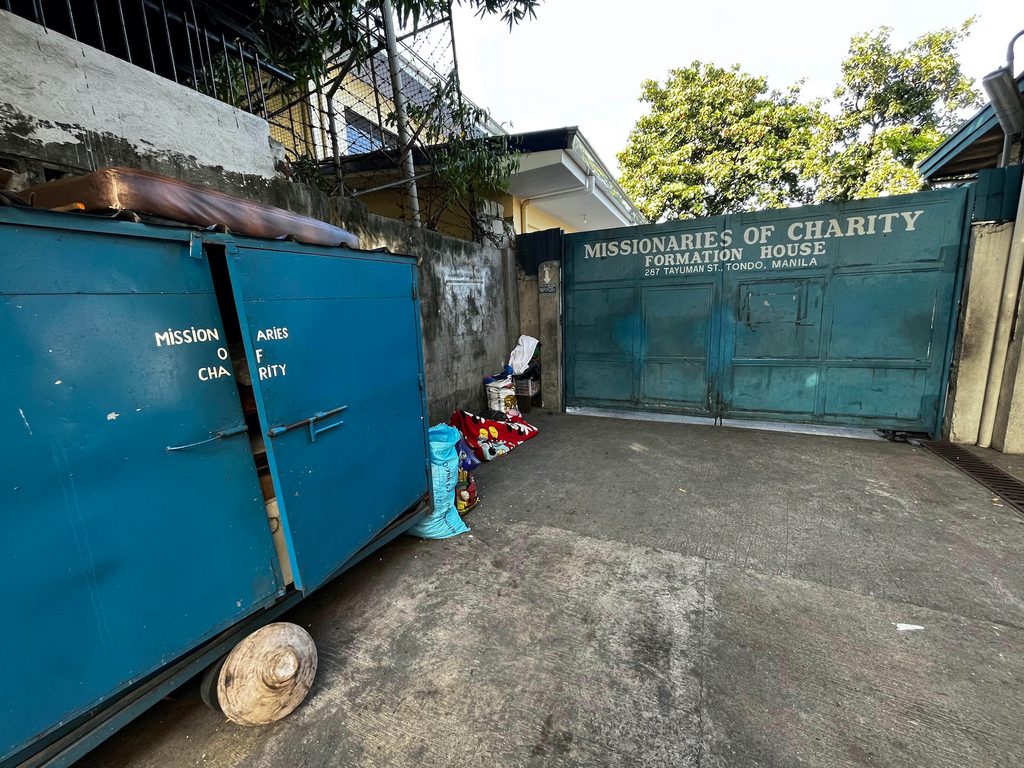SUMMARY
This is AI generated summarization, which may have errors. For context, always refer to the full article.

MANILA, Philippines – Exactly nine days before Christmas, as dawn Masses called Simbang Gabi began in the Philippines, a 63-year-old Filipina nun came closer to danger in Gaza City.
Local church leaders said the Israeli military “targeted” on Saturday, December 16, the convent of the Missionaries of Charity in Gaza, home to at least 54 persons with disabilities (PWDs) sheltered by Catholic nuns.
The Filipina nun is one of the Missionaries of Charity sisters serving in Gaza.
The Philippine Department of Foreign Affairs (DFA) has declined to identify the Filipina nun, but her congregation, the Missionaries of Charity based in India, confirmed to Rappler the Filipina’s name: Sister Elisabeth Ann.
The attack by the Israel Defense Forces on Saturday destroyed the generator of the Missionaries of Charity convent, which was their only source of electricity. This “rendered the home uninhabitable,” said the Latin Patriarchate of Jerusalem. This means the 54 PWDs under the sisters’ care are now homeless “and without access to the respirators that some of them need to survive.”
Rappler has reached out to the Missionaries of Charity headquarters in India, as well as to the Philippine Embassy in Amman, Jordan, to ask about the situation of Sister Elisabeth Ann and the other sisters after Saturday’s attack. We will update this story once they respond.
Rappler learned that Sister Elisabeth Ann from the Philippines is one of three Missionaries of Charity sisters serving in Gaza – along with Sister Bathilda from India and Sister Gabriel from Rwanda.
All three of them have chosen to remain in Gaza to take care of around 30 children with disabilities and 30 poor and sick people in their convent. The Missionaries of Charity have appealed for prayers for the three sisters.
In a phone conversation, the sisters told the superior general of the Missionaries of Charity, Sister M. Joseph, around a month and a half ago: “We are in the hands of God. Please do not worry about us.”
The superior general was “totally amazed” at the joy and peace in their hearts despite the war.
Undersecretary Eduardo de Vega, who deals with migrant workers for the DFA, told reporters on October 25 that the Filipina nun is determined to fulfill her calling.
“She has a calling, you know. Maybe you can give me advice. I mean, how do you tell a sister, if she says this is her calling, how do we tell her, ‘Get out of there’? Maybe God is calling on her to stay there. Hopefully, she’ll be repatriated. Hopefully, she’ll accept it,” De Vega said.
Weeks later, on November 13, De Vega told Arab News that the Filipina nun still refuses to leave Gaza.
“She’s with the Missionaries of Charity…. They will not leave. After all, they believe… that (what they are doing) is spiritual,” said De Vega in an interview with Arab News.
“She will be the last Filipino left in Gaza, (and) is a symbol of Filipino spirituality and how we pray for solidarity with those suffering, and for world peace,” he added.
‘Angels of Gaza’ for 50 years
One can expect nothing less from the Missionaries of Charity, a congregation founded in 1950 by the late Mother Teresa of Calcutta, a Catholic saint known for embracing the most difficult missions for the sake of the poor.

Mother Teresa – who was born to Albanian parents in Macedonia and died in India at the age of 87 on September 5, 1997 – won the Nobel Peace Prize in 1979 “for her work for bringing help to suffering humanity.” Known as the “living saint” when she was alive, Mother Teresa was canonized by Pope Francis on September 4, 2016, officially making her a Catholic saint.
Mother Teresa cared for the dying, sheltered the homeless, and even nursed lepers despite the stigma associated with leprosy. In a 1974 interview, Mother Teresa said: “I see God in every human being. When I wash the leper’s wounds I feel I am nursing the Lord himself. Is it not a beautiful experience?”
It is the same example that the Missionaries of Charity, the spiritual daughters of Mother Teresa, seek to emulate in the world’s orphanages, elderly homes, and war zones like Gaza.
The Missionaries of Charity arrived in Gaza on February 26, 1973, and have never left since then. They marked their golden jubilee, their 50th year in Gaza, this year.
Father Gabriel Romanelli, priest of the Latin parish in Gaza, said in a Christian Media Center interview that the sisters arrived on “a very special and difficult day.” It was only hours after the parish priest, Father Hanna Al-Nimri, was murdered.
The sisters’ first task: to clean the monastery walls of Al-Nimri’s blood.

In this interview that aired on February 17 this year, Romanelli said the Missionaries of Charity run two homes in Gaza – one for children with special needs and another for adults in the same situation. They serve a total of 70 people, he said.
The Missionaries of Charity also provide “spiritual assistance” to the parish in Gaza and “visit hundreds of homes of the poor, the needy, and the sick.”
“They are a great blessing for Gaza, the Palestinian society, the Catholic Church, and all Christians, Muslims, and every citizen, because these nuns are the angels of Gaza,” Romanelli said.
In 1998, a martyred Filipina nun
In the Philippines, the Missionaries of Charity run many orphanages, feed malnourished children, and care for the dying and the destitute.
They have at least 70 Filipinas and 54 foreigners who are perpetually professed sisters, and at least 21 temporary professed sisters, in the Philippines. Wearing the white sari with three blue borders or stripes associated with Mother Teresa, they are known here to live simple, quiet lives.

To know more about Sister Elisabeth Ann and the Missionaries of Charity, I visited their headquarters in Tayuman, Manila, in the afternoon of November 16, and found a flurry of activity.
Under the heat of the sun, at around 2:40 pm that Thursday afternoon, a group of five or seven sisters was crossing the road – the vehicles stopped as the women in robes passed by – from their formation house to their nearby home for children. At their children’s home, they joined a bigger group of nuns in communal prayer at 3 pm.
A handful of others were getting off another L300, carrying with them what appeared to be one-serving containers of consumed food. I was thinking, did they come from a feeding activity?
In their other house dedicated to formation, one of their more senior members was carrying boxes of eggs stacked upon each other, loading them onto what appeared to be an L300 van. As I offered help, the sister told me the eggs were donations coursed through the Missionaries of Charity, which would then be transported to faraway Aparri, a town in the northernmost part of the Philippine archipelago.
When I told the sisters I was doing research on Sister Elisabeth Ann, I was asked to stay in a waiting area.
The waiting room was a story in itself.
Plastered on one of its walls was a 2007 poster, which indicated the areas around the world that the Missionaries of Charity served. At that time, they had 757 sisters worldwide. The list of places where they were present in the Middle East included a subheading titled “Palestine,” under which was listed “Gaza, Nablus, Bethlehem.”
Under the Middle East portion was a special heading, in bigger, bolder letters: “MARTYRED.” Below the heading were the words “on 27.07.98 (Hebeidah, Yemen).” Then there were the photos of three sisters, including a Filipina.

Sister Mary Michael, a 36-year-old Filipina nun, was martyred by a suspected extremist along with Sister Mary Zelia of Rwanda and Sister Mary Aletta of Orissa in Hodeidah, Yemen, on July 27, 1998. The Washington Post reported that the sisters, which the paper described as “medical nuns,” were “killed on their way from their home to work as nurses at a charity organization.”
When the suspect, Abdullah Nasheri, was interrogated by authorities, Nasheri said he killed the three nuns of Mother Teresa for “preaching Christianity.”
To this day, Pope Francis himself remembers their martyrdom. In his General Audience on April 19, he said their death is among “brilliant testimonies of faith” that “paved the way for others” to continue to serve “the sick, elderly, and disabled.”
The Missionaries of Charity, however, are also known to shun publicity. Only a few photos of them performing charity work, in fact, can be found on social media.
When I was led out of the waiting room, one of the sisters regretfully informed me that they cannot share details about Sister Elisabeth Ann in Gaza, and that the information I received from their headquarters in India was enough.
She then gave me a stampita (prayer card) of Mother Teresa and led me to a small chapel. Having declined an interview, she told me to pray instead.
The prayer room is simple: there is a banig (a traditional handwoven mat) on the red tiled floor, and the white walls are unadorned. There is only a crucifix, a statue of the Virgin Mary wearing white, and a tabernacle containing the Blessed Sacrament, a piece of bread that Catholics believe to have been “transubstantiated” into the real body of Christ.
Beside the crucifix in this room, however, are two words of Christ in the Bible, uttered in exhaustion as he was hanging on the cross.

It is the call that the sisters hear, perhaps, even in the world’s danger zones, the reason why the likes of Sister Elisabeth Ann refuse to leave Gaza.
It is a plea from Christ on the cross, who said whatever we do to our neighbor, we do to him: one of his seven last words, “I thirst.” – with reports from Alec Reguya/Rappler.com
Add a comment
How does this make you feel?
![[The Wide Shot] Peace be with China](https://www.rappler.com/tachyon/2024/07/wideshot-wps-catholic-church.jpg?resize=257%2C257&crop=311px%2C0px%2C720px%2C720px)
![[OPINION] A critique of the CBCP pastoral statement on divorce](https://www.rappler.com/tachyon/2024/07/TL-cbcp-divorce-statement-july-19-2024.jpg?resize=257%2C257&crop=285px%2C0px%2C722px%2C720px)


![[The Wide Shot] Was CBCP ‘weak’ in its statement on the divorce bill?](https://www.rappler.com/tachyon/2024/07/cbcp-divorce-weak-statement.jpg?resize=257%2C257&crop=258px%2C0px%2C719px%2C720px)

![[REFLECTION] Mary, Mother of the West Philippine Sea](https://www.rappler.com/tachyon/2024/07/may-mother-west-ph-sea-july-19-2024.jpg?resize=257%2C257&crop=293px%2C0px%2C751px%2C750px)
![[OPINION] Ignorance and prejudice](https://www.rappler.com/tachyon/2024/07/tl-ignorance-and-prejujdice.jpg?resize=257%2C257&crop_strategy=attention)
There are no comments yet. Add your comment to start the conversation.